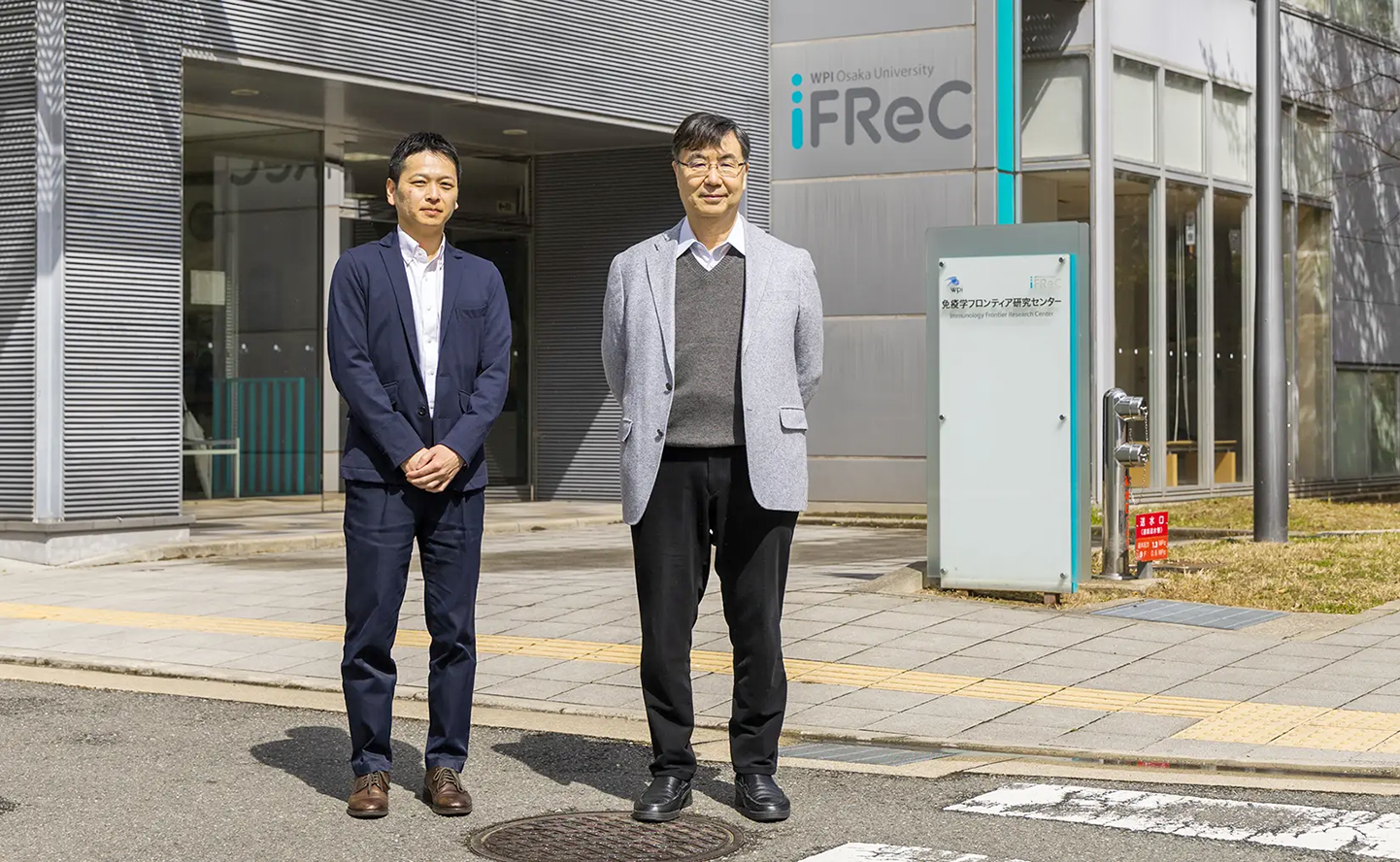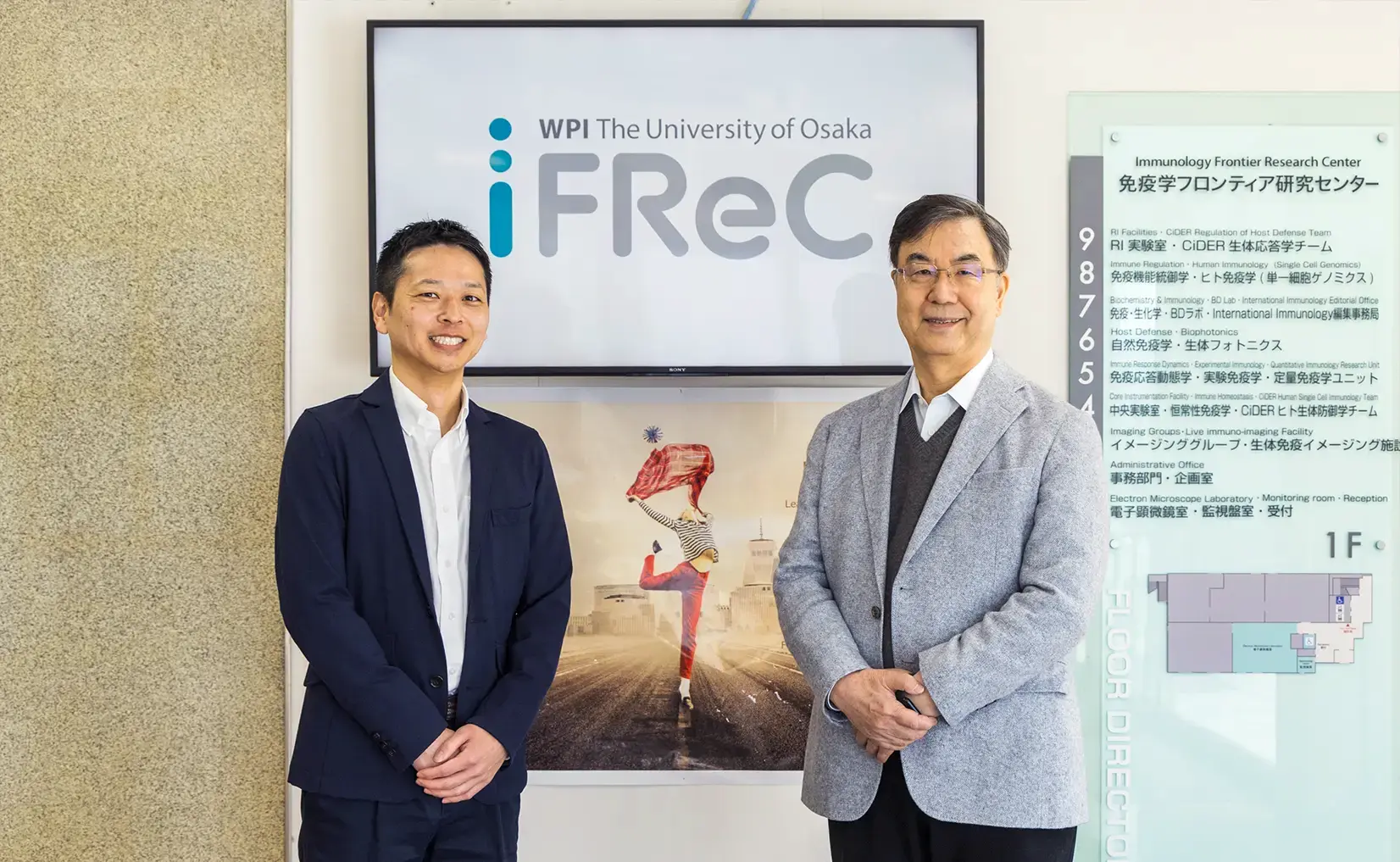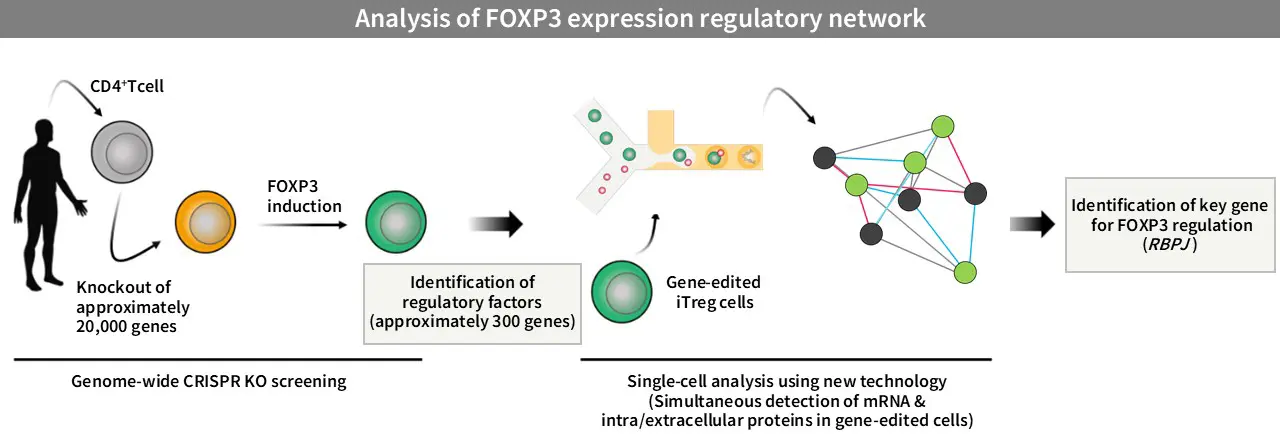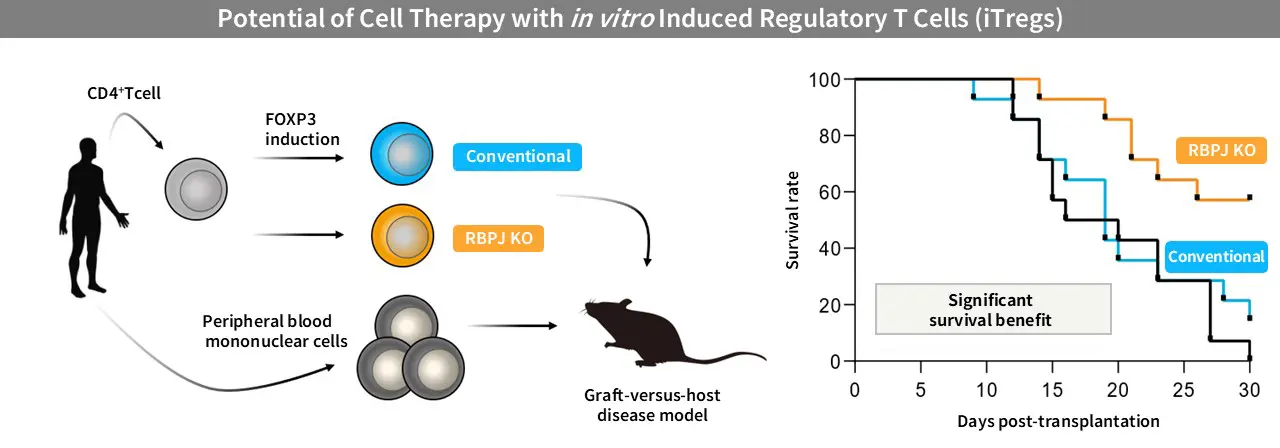Creating and Expanding Regulatory T cells: The Possibility of Cellular Therapy Explored by a Joint Research Team from Chugai and the Immunology Frontier Research Center (IFReC), the University of Osaka
- Innovation
- R&D

The immune system protects the body from harm. In this process, regulatory T cells act as regulators or brakes suppressing excessive immune responses. A recent Joint research by the University of Osaka Immunology Frontier Research Center (IFReC) and Chugai Pharmaceutical has revealed a new mechanism that regulates the FOXP3 protein, which plays a vital role in the function of regulatory T cells (Nature, March 26, 2025). *¹
Tatsuya Kibayashi (Drug Discovery and Pharmacology II Research Department, Chugai Pharmaceutical), who led the research, explains how FOXP3 controls the immune system and whether it holds promise for opening a new avenue in the development of cellular therapies for conditions such as autoimmune diseases. We also hear from Dr. Shimon Sakaguchi, a Specially Appointed Professor (full-time) at IFReC, about his belief in “valuing an environment where academia and corporations can stimulate each other to generate new ideas” and thoughts on open innovation.
What is the Regulatory T cell (Treg)?
The human body is equipped with a complex immune system that protects the body against foreign invaders. Tregs play a pivotal role in this system. Although Tregs account for only a small percentage of immune cells (e.g., lymphocytes), they are capable of suppressing autoimmune responses. Since their existence was first reported by Dr. Shimon Sakaguchi in 1995, the functions of Tregs have been gradually revealed.*2
Tregs primarily regulate the activity of other immune cells. For example, they suppress excessive immune responses. However, reduced Treg function can disrupt the balance of the immune system, potentially leading to autoimmune diseases, such as IPEX syndrome, rheumatoid arthritis, type-1 diabetes, and multiple sclerosis. Conversely, overactive Tregs can suppress antitumor immune responses, potentially worsening cancer.*3
Currently, studies are under way worldwide to treat diseases by increasing or eliminating Tregs, which are broadly involved in immune system regulation.
IPEX syndrome: A syndrome involving immune abnormalities caused by mutations in FOXP3 IPEX stands for immune dysregulation, polyendocrinopathy, enteropathy, X-linked syndrome. Patients with IPEX syndrome present with severe allergies, autoimmune thyroid disorders, type 1 diabetes, and inflammatory bowel disease.*4
Elucidation of the Network Controlling FOXP3 Expression Opening up the Potential for Induced Regulatory T cell (iTreg) Cellular Therapy
A joint research team from the University of Osaka IFReC and Chugai recently discovered a new mechanism for controlling Tregs and identified the potential to manipulate this mechanism to treat autoimmune diseases (Nature, March 26, 2025) . The key lies in FOXP3, a protein essential for the differentiation and function of Tregs known as thier master regulator.
“First, we used genome-wide CRISPR KO screening to comprehensively survey approximately 20,000 human genes for their involvement in regulating FOXP3 induction and expression, narrowing the list of key factors to a few hundred. Next, using single-cell analysis, we identified the signaling pathways that control FOXP3 and related factor groups, based on relationships deduced from changes in gene expression and FOXP3 protein levels resulting from gene knockouts (inactivation of target genes). By combining genome-wide CRISPR KO screening with single-cell analysis, we identified RBPJ as a protein that plays a central role in the network that suppresses FOXP3 expression—this was a major discovery,” said Tatsuya Kibayashi, a researcher at Chugai.
CRISPR KO screening: A technique used to comprehensively identify genes with specific functions using the genome-editing technology CRISPR-Cas9. It involves “gene knockout” to inactivate specific genes in order to study their original roles on a genome-wide scale.
Single-cell analysis: A technique for analyzing cellular functions. This allows researchers to obtain and assess data on protein and mRNA expression in individual cells. Whereas bulk cell analysis provides average data across many cells, single-cell analysis offers a more detailed examination of cellular diversity. The single-cell analysis used in the Osaka University-Chugai research article was performed by modifying cell fixation and membrane permeabilization methods to enable the simultaneous detection and analysis of proteins and mRNA within cells—a technique previously considered challenging. The analysis also employed a method (Perturb-seq) to identify individual cells with gene edits, achieving both high-resolution and high-throughput characterization.
After elucidating the network controlling FOXP3 expression in Tregs, a joint research team explored the potential of Treg-cell therapy.
In addition to immune checkpoint inhibitors and CAR T-cell therapy in oncology, Treg-cell therapy is an immunotherapeutic approach that has attracted attention in the field of autoimmune diseases. Tregs from a patient’s body are expanded in vitro and transferred back to the patient to rebalance the immune system. While CAR-Treg therapy—an approach that has developed rapidly in recent years—targets a single (or a few) autoantigens associated with a specific condition, in vitro-induced Treg (iTreg) therapy targets a group of autoantigens related to the condition.
“In an animal experiment, Tregs induced from RBPJ knockout T cells derived from human peripheral blood (RBPJ KO-iTregs) were transplanted into animals. We confirmed that iTreg therapy had an enhanced inhibitory effect against immune rejection, which negatively affects survival rates. I would say that the results of this study offer key insights to help improve iTreg induction efficiency, function, and stability.” says Kibayashi.
Immune checkpoint inhibitors: Drugs that reactivate immune cells by disrupting mechanisms exploited by cancer cells to evade immune attack.
CAR-T cell therapy: A treatment method that attacks cancer cells by genetically modifying T cells harvested from a patient’s blood to recognize specific tumor antigens.
Aiming for Research Advancements through Industry-Academia Collaboration and Open Innovation
As a way to give back to society through the findings of advanced immunological research, Chugai has been conducting various joint projects with the University of Osaka IFReC since 2017 under a comprehensive collaboration agreement. Through this partnership, Chugai shares its proprietary drug discovery technologies and expertise in exchange for new academic discoveries.
Kibayashi says, “We were able to conduct a study that could link the scientific significance of regulatory T cells to their therapeutic application. I specialize in pharmacological research. Eight years ago, I was dispatched from Chugai’s Research Institute to the Collaboration Promotion Laboratory at IFReC. The theme of our paper, published in Nature, was developed through discussions starting from a blank slate with Dr. Sakaguchi, Dr. Chen and other researchers at IFReC. I believe that building trusting relationships is the most crucial element in promoting open innovation. It is likely that years will pass before the outcomes of this study lead to the clinical application of iTreg cell therapy to benefit patients. Even so, I think we have just taken a major step toward its realization.”

Dr. Shimon Sakaguchi, a research collaborator, praised the discovery, saying, “Kibayashi-san did an excellent amid a global research trend of exploring whether decreasing Tregs can be applied to cancer treatments or increasing Tregs can be applied to autoimmune disease treatments.” He continued, “Today, anyone can obtain information, but it is crucial to remember that research is fundamentally a human endeavor.
The acquisition of new techniques and knowledge does not automatically advance research. Through joint research, academia and businesses can stimulate each other and generate innovative ideas that cannot be conceived individually. Corporate researchers involved in basic research at IFReC return to their companies with newly gained experience, which contributes to the development of human resources. I would like to help strengthen the research capabilities of Japanese pharmaceutical companies in the long run,” expressing his thoughts on open innovation.
Chugai has accelerated open innovation in drug discovery. Further advancements in joint industry-academia research will continue to attract interest.
The information and affiliations in this article are as of March 2025.
References
*1 Chen, K.Y., Kibayashi, T. et al.: Genome-wide CRISPR screen in human T cells reveals regulators of FOXP3.Nature (2025). doi:10.1038/s41586-025-08795-5.
*2 Sakaguchi, S., et al.: Immunologic self-tolerance maintained by activated T cells expressing IL-2 receptor alpha-chains (CD25). Breakdown of a single mechanism of self-tolerance causes various autoimmune diseases. J Immunol.,155(3),1151-64(1995)
*3 Wadell, C.M. et al.: Harnessing the biology of regulatory T cells to treat disease. Nat Rev Drug Discov., 24(2), 93-111(2025)
*4 Bacchetta, R., Roncarolo, M.G.: IPEX syndrome from diagnosis to cure, learning along the way. J Allergy Clin Immunol., 153(3), 595-605(2024)
[Relevant information]
https://www.chugai-pharm.co.jp/english/innovation/rd/features.html#sec02
Tatsuya Kibayashi (Drug Discovery and Pharmacology II Research Department)
Kibayashi joined Chugai Pharmaceutical in 2013. His area of specialty is pharmacology. Until his fourth year with Chugai, he was primarily involved in oncology, focusing on efficacy evaluations of antibody drug candidates, new target discovery, and the development of new antibody technologies. After working at the former Kamakura and Fuji Gotemba Research Laboratories, Kibayashi was dispatched in April 2017 to the University of Osaka Immunology Frontier Research Center, where he has been engaged in joint research on regulatory T cells under the guidance of Professor Shimon Sakaguchi in Experimental Immunology.






